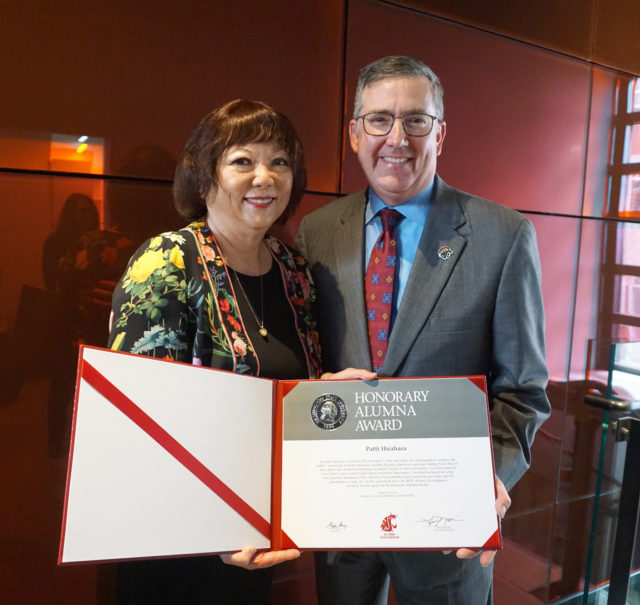by Steve Nakata, Retrieved from Washington State University Press Release
Ever since Patti Hirahara donated to Washington State University over 2,000 photos taken by her father and grandfather while in a Japanese American incarceration camp during WWII, she has dedicated her life to serving as an ambassador for WSU promoting the collection and educating others about the Japanese American legacy.
The WSU Alumni Association honored Hirahara, of Anaheim, Calif., for her dedication by presenting her with the Honorary Alumna Award following a recent speech she gave at WSU Spokane’s Student Diversity Center.
It is the most prestigious award given to non-WSU graduates by the Alumni Association. Established in 1966, it honors friends of WSU who have given special service to the university.
“We are thrilled to honor Patti,” said Tim Pavish, executive director of the WSU Alumni Association. “She is a remarkable person, and we are lucky to have her in the WSU family.”
Father-son team capture history
During World War II, Hirahara’s father, grandparents and great-grandparents were forced to leave their homes in Yakima, Wash., under the direction of President Franklin D. Roosevelt’s Executive Order 9066. While they lived in Wyoming’s Heart Mountain Relocation Center, her father Frank and grandfather George documented everyday life inside the camp using camera equipment purchased from the Sears Roebuck and Montgomery Ward catalogs. They developed and printed their photos in a secret underground darkroom built by George under the family’s barrack.
As a citizen of Japan, George was not allowed to possess camera equipment at the time. Frank was born in Yakima, and as a U.S. citizen, could have photographic equipment that was ultimately used by the family. Together they went about capturing history. After graduating from Heart Mountain High School, Frank attended WSU where he earned a bachelor’s degree in electrical engineering in 1948.
Finding a home for the photos
In 2010, Patti donated the original negatives and photos to the WSU Libraries Manuscripts, Archives, and Special Collections (MASC). It is considered to be the largest private collection of photos taken by amateur photographers incarcerated behind barbed wire in Heart Mountain.
Once WSU acquired the collection, MASC received funding from the National Park Service’s Japanese American Confinement Sites Grant Program to preserve, clean and digitize the negatives for future generations. After becoming accessible to the public online, documentary filmmakers, authors, the Broadway musical Allegiance, the FDR Presidential Library and Museum and the Smithsonian National Museum of American History have utilized the photographs. They can be viewed at libraries.wsu.edu/hirahara.
Spreading the word
Hirahara has worked more than six years locating many of the people in the photos. By sharing them with family descendants, she offered them a piece of history that they never knew existed. She plans to donate to WSU additional information of what she has learned.
In 2014, Hirahara spearheaded a series of workshops, films and presentations for an unprecedented campuswide look at the incarceration of Japanese Americans during World War II. She has shared her family’s story and photo collection with more than 1,000 students on campus and recently established the Frank C. Hirahara Excellence Fund in his honor. https://museum.wsu.edu/events/event-archive/
She is particularly proud and amazed that in 1946 her father was elected by the Associated Students of WSU (ASWSU) to its Athletic Council. As a Japanese American and a track athlete just one year after the conclusion of World War II, he received the second highest vote tally of anyone on the ballot.
Hirahara said receiving this award is significant because this year marks the 75th anniversary of when her father and grandfather began taking photos in the camp.
“WSU’s history is unknown to many people, especially the fact that the university allowed Japanese American students to continue their education during WWII,” she said. “It is an extreme honor to be recognized by my father’s alma mater and it has been a wonderful partnership with WSU over the last eight years.”







